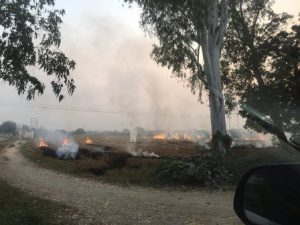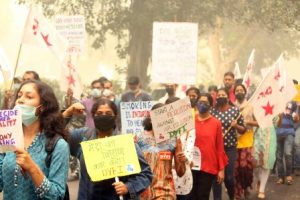The Capital Health Emergency: Hazy Times Ahead?
The National Capital is choking due to the worst air quality. Schools have declared holidays, citizens are wearing a face mask, hospitals’ number of ailing patients is growing; however, political class continues with their routine blame game.

It has been a week that large areas of North India, including the capital city Delhi, have been blanketed with thick smog. This toxic blanket of smog, which as we know is an unhealthy concoction of poisonous gases and particulate matter, engulfs Delhi as well as most of North India almost every year, at the onset of winter. This annual feature is highly unhealthy and can cause irreparable damage to the lungs and respiratory functions of even the healthiest of individuals. But while the Air Quality Index (AQI) reaches new heights, which in simple terms can only be termed as pathetic, the response to battle it from the side of the government has been anything but apathetic.
The Deadly Sunday
On Sunday, the national capital was engulfed by a dense smog t hat reduced visibility and brought the air quality to its worst level since 2016. Air quality is usually considered good when the Air Quality Index is below 50 and satisfactory when it is under 100. However, according to the Central Pollution Control Board (CPCB)’s recent bulletin, the AQI for the past 24 hours till Sunday has sharply risen from 399 to 494; the worst level recorded since 6 November 2016. Even though the average Delhite was left gasping for breath, the leaders from major political spectrums were too occupied in their blame game, over the causes of such an alarming rise in the pollution level.
Also Read : Air Pollution Sees Over Half Of Deaths In Persons Younger Than 70 Confirms Icmr
The Noxious Smog
Many believe that the chief reason for the smog engulfing Delhi is a result of the burning of stubble or crop residue in the states of Punjab and Haryana. While the stubble burning is, in fact, a major factor for the resultant air pollution, it is not the only one. Experts believe that the reasons can be as diverse as meteorological and atmospheric factors, road and construction dust and automobile emissions. Perhaps, the time of initiation and viability of the Graded Response Action Plan needs thorough scrutiny.
The Response: Too Little and Too Late
It becomes impertinent that the menace of the smog needs to be battled as a war as it has become an annual affair. But the question on how is still hanging loosely?
To reach some conclusive steps that can curtail pollution, some cohesive data is required but that has been a problem.

In September 2019, the Delhi government claimed that the pollution levels in the National Capital Region (NCR) have dropped by 25 per cent. For this claim, the Delhi government cited the data compiled by the Central Pollution Control Board.
The problem of Delhi’s chronic air pollution has been debated in both the Houses of the Parliament over the months in 2019. Interestingly, different sets of data had been submitted during the debates at the Lok Sabha and the Rajya Sabha. In the Rajya Sabha in February 2019, the annual average for PM2.5 levels was cited to be 135 in 2016, 124 in 2017 and 115 in 2018. In July 2019, the data cited was different. The annual averages if PM2.5 levels were reported to be 118 in 2016, 106 in 2017 and 121 in 2018. The question then arises that which data is correct, and how that can be ascertained? What such ‘data-gaps’ and differences mean is that even if the PM2.5 levels have reduced in Delhi as claimed by the government, it is difficult to ascertain the reason behind it. This lack of clarity makes it difficult to reach conclusions regarding the workability of different projects or the focus of future projects and directives in order to reverse the increasing pollution in the region.
Also Read : Frame Guidelines On Burning Of Ravana Effigies Delhi Hc To Centre And State
On Monday, 4 November 2019, the Delhi Government’s odd-even rationing scheme, an anti-pollution measure kicked in. The same day, the Supreme Court asked the governments of Punjab, Haryana and Uttar Pradesh to immediately stop their farmers from stubble burning. The Court stated that any instance of stubble burning from now on would be penalized, making the local and civic bodies ‘personally responsible’ for the farmers burning the crop residue. While penalty may be a deterrent for any such future incident of stubble burning, it comes too late; particularly, when satellite images have been showing widespread fires raging across the two north Indian states. Further, the process of prevention of such field fires as well as providing the farmers with viable alternatives should have been the focus of both the state and the central governments. No one should not have waited for a rap on the knuckles by the Supreme Court when the smog from the stubble burning has reached alarming levels.
Another set of directives issued by the Supreme Court have also imposed fines on construction and demolition activities in the region. While any such measures will be welcomed, the average citizens shrouded in the toxic haze is certainly waiting for some accountability and stringent measures so that their health can be spared.
